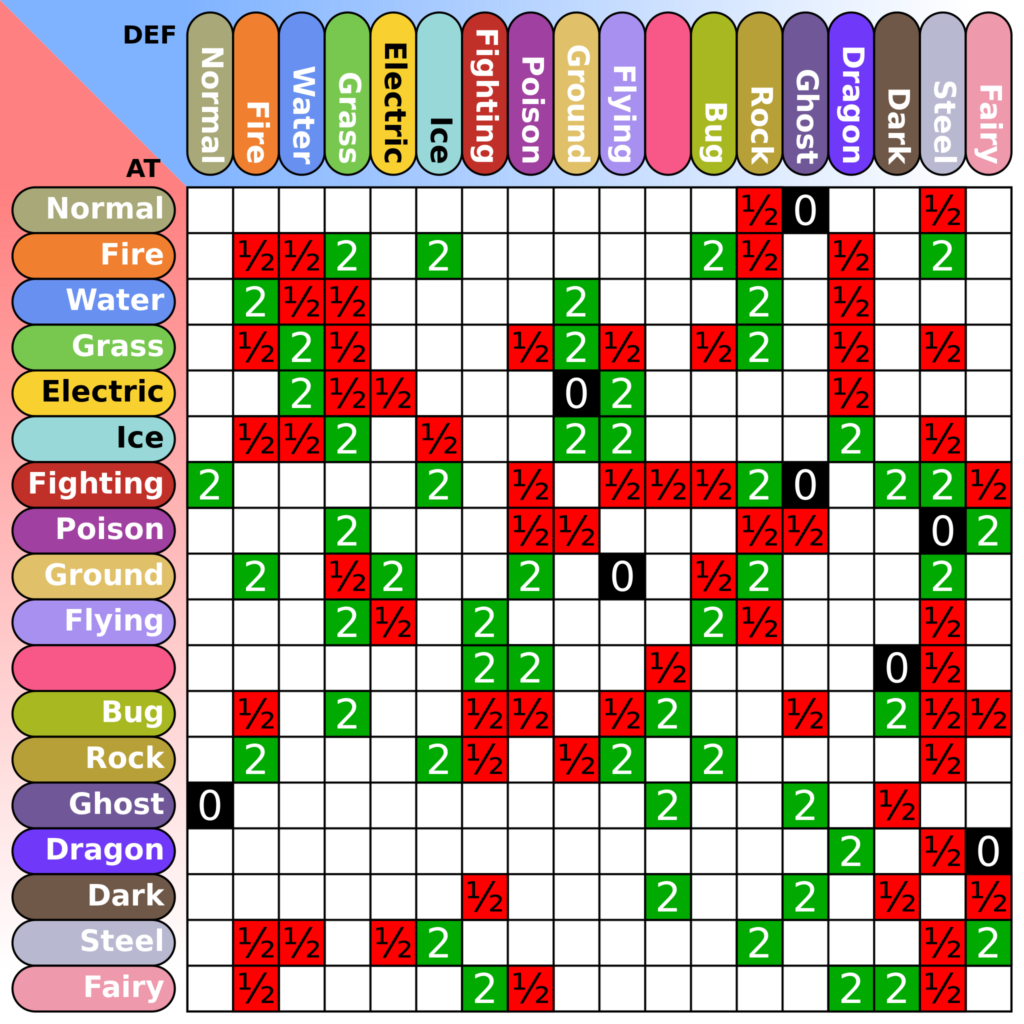Pokemon Type Chart: A Complete Guide for Pokemon Trainers
Learn everything you need to know about the Pokemon type chart, a tool that shows the strengths and weaknesses of each Pokemon type in relation to each other.

If you are a pokemon trainer, you probably know that there are different types of pokemon, such as fire, water, electric, grass, and so on. But do you know how these types affect the outcome of a pokemon battle? Do you know which types are strong or weak against each other? Do you know how to use the pokemon type chart to your advantage?
A pokemon type chart is a tool that shows the strengths and weaknesses of each pokemon type in relation to each other. It can help you decide which pokemon to use in a battle, which moves to choose, and which strategies to employ. By understanding the pokemon type chart, you can become a better pokemon trainer and win more battles.
In this article, we will explain the basics of the pokemon type chart, and then go over each pokemon type in detail. We will discuss their characteristics, advantages, disadvantages, and examples of pokemon that belong to each type. We will also provide some tips and tricks for using the pokemon type chart effectively. By the end of this article, you will have a comprehensive knowledge of the pokemon type chart and how to use it in your pokemon adventures.

Normal type
Normal type pokemon are the most common and diverse type. They can learn a variety of moves, but they have no special abilities or resistances. They are usually well-rounded and balanced, but they lack a distinct edge over other types.
Normal type pokemon are weak against fighting type pokemon, which can easily overpower them with physical attacks. They are immune to ghost type pokemon, which cannot harm them with their spooky moves. They have no other strengths or weaknesses.
Some examples of normal type pokemon are Rattata, Snorlax, Eevee, and Ditto.
Fire type
Fire type pokemon are hot and fiery. They can burn their opponents with powerful fire moves, and they are resistant to ice, bug, grass, and steel type pokemon, which are vulnerable to heat. They are also immune to being burned by other fire moves.
Fire type pokemon are weak against water, rock, and ground type pokemon, which can extinguish their flames with water, rock, or dirt. They also have a disadvantage in rainy weather, which reduces the power of their fire moves.
Some examples of fire type pokemon are Charmander, Vulpix, Magmar, and Moltres.
Water type
Water type pokemon are wet and aquatic. They can soak their opponents with powerful water moves, and they are resistant to fire, ice, steel, and water type pokemon, which are susceptible to water. They also have an advantage in rainy weather, which boosts the power of their water moves.
Water type pokemon are weak against electric and grass type pokemon, which can zap or drain them with their moves. They also have a disadvantage in sunny weather, which reduces the power of their water moves.
Some examples of water type pokemon are Squirtle, Psyduck, Lapras, and Gyarados.
Electric type
Electric type pokemon are fast and energetic. They can shock their opponents with powerful electric moves, and they are resistant to electric, flying, and steel type pokemon, which are conductive to electricity. They are also immune to being paralyzed by other electric moves.
Electric type pokemon are weak against ground type pokemon, which can ground them and block their electric currents. They have no other strengths or weaknesses.
Some examples of electric type pokemon are Pikachu, Voltorb, Jolteon, and Zapdos.
Grass type
Grass type pokemon are green and natural. They can grow and heal themselves with grass moves, and they are resistant to water, electric, grass, and ground type pokemon, which are nourished by plants. They also have an advantage in sunny weather, which enhances the power of their grass moves.
Grass type pokemon are weak against fire, ice, poison, bug, and flying type pokemon, which can burn, freeze, poison, eat, or cut them with their moves. They also have a disadvantage in rainy weather, which reduces the power of their grass moves.
Some examples of grass type pokemon are Bulbasaur, Oddish, Exeggutor, and Celebi.
Ice type
Ice type pokemon are cold and frozen. They can chill their opponents with ice moves, and they are resistant to ice type pokemon, which are used to low temperatures. They also have an advantage in hail weather, which boosts the power of their ice moves and damages non-ice pokemon.
Ice type pokemon are weak against fire, fighting, rock, and steel type pokemon, which can melt, break, or crush them with their moves. They have no other strengths or weaknesses.
Some examples of ice type pokemon are Jynx, Lapras, Articuno, and Glaceon.
Fighting type
Fighting type pokemon are strong and muscular. They can punch and kick their opponents with fighting moves, and they are effective against normal, ice, rock, dark, and steel type pokemon, which are weak to physical attacks. They also have an advantage in cloudy weather, which increases the power of their fighting moves.
Fighting type pokemon are weak against flying, psychic, and fairy type pokemon, which can dodge, outsmart, or charm them with their moves. They have no other strengths or weaknesses.
Some examples of fighting type pokemon are Machop, Hitmonlee, Lucario, and Blaziken.
Poison type
Poison type pokemon are toxic and venomous. They can poison their opponents with poison moves, and they are resistant to grass, fighting, poison, and bug type pokemon, which are less affected by toxins. They are also immune to being poisoned by other poison moves.
Poison type pokemon are weak against ground and psychic type pokemon, which can cleanse or overpower them with their moves. They have no other strengths or weaknesses.
Some examples of poison type pokemon are Ekans, Nidoran, Koffing, and Gengar.
Ground type
Ground type pokemon are dirty and earthy. They can shake and bury their opponents with ground moves, and they are effective against fire, electric, poison, rock, and steel type pokemon, which are vulnerable to earth. They are also immune to electric moves, which cannot reach them underground.
Ground type pokemon are weak against water, grass, and ice type pokemon, which can wash, grow, or freeze them with their moves. They also have a disadvantage in snowy weather, which reduces the power of their ground moves.
Some examples of ground type pokemon are Diglett, Sandshrew, Cubone, and Groudon.
Rock type
Rock type pokemon are hard and solid. They can smash and crush their opponents with rock moves, and they are effective against fire, ice, flying, and bug type pokemon, which are fragile to rocks. They also have an advantage in sandstorm weather, which boosts the power of their rock moves and damages non-rock pokemon.
Rock type pokemon are weak against water, grass, fighting, ground, and steel type pokemon, which can erode, pierce, or shatter them with their moves. They also have a disadvantage in rainy weather, which reduces the power of their rock moves.
Some examples of rock type pokemon are Geodude, Onix, Rhyhorn, and Tyranitar.
Bug type
Bug type pokemon are small and creepy. They can bite and sting their opponents with bug moves, and they are effective against grass, psychic, and dark type pokemon, which are preyed upon by bugs. They also have an advantage in foggy weather, which increases the power of their bug moves.
Bug type pokemon are weak against fire, flying, and rock type pokemon, which can burn, swat, or squash them with their moves. They have no other strengths or weaknesses.
Some examples of bug type pokemon are Caterpie, Weedle, Scyther, and Heracross.
Ghost type
Ghost type pokemon are spooky and mysterious. They can haunt and curse their opponents with ghost moves, and they are effective against psychic and ghost type pokemon, which are scared or harmed by ghosts. They are also immune to normal and fighting moves, which cannot touch them.
Ghost type pokemon are weak against dark and ghost type pokemon, which can resist or fight back against their ghostly powers. They have no other strengths or weaknesses.
Some examples of ghost type pokemon are Gastly, Misdreavus, Duskull, and Rotom.
Steel type
Steel type pokemon are tough and metallic. They can slash and defend themselves with steel moves, and they are resistant to normal, grass, ice, flying, psychic, bug, rock, dragon, steel, and fairy type pokemon, which are less effective against metal. They are also immune to being poisoned by other poison moves.
Steel type pokemon are weak against fire, fighting, and ground type pokemon, which can melt, dent, or bury them with their moves. They have no other strengths or weaknesses.
Some examples of steel type pokemon are Magnemite, Steelix, Scizor, and Metagross.
Psychic type
Psychic type pokemon are smart and mental. They can manipulate and attack their opponents with psychic moves, and they are effective against fighting and poison type pokemon, which are weak to mental attacks. They also have an advantage in windy weather, which increases the power of their psychic moves.
Psychic type pokemon are weak against bug, ghost, and dark type pokemon, which can exploit their mental weaknesses with their moves. They have no other strengths or weaknesses.
Some examples of psychic type pokemon are Abra, Slowpoke, Alakazam, and Mewtwo.
Dragon type
Dragon type pokemon are powerful and majestic. They can roar and blast their opponents with dragon moves, and they are effective against dragon type pokemon, which are the only ones who can match their strength. They also have an advantage in stormy weather, which boosts the power of their dragon moves.
Dragon type pokemon are weak against ice, dragon, and fairy type pokemon, which can freeze, rival, or enchant them with their moves. They have no other strengths or weaknesses.
Some examples of dragon type pokemon are Dratini, Dragonair, Dragonite, and Rayquaza.
Dark type
Dark type pokemon are sneaky and evil. They can trick and bite their opponents with dark moves, and they are effective against psychic and ghost type pokemon, which are vulnerable to dark attacks. They are also immune to psychic moves, which cannot affect them.
Dark type pokemon are weak against fighting, bug, and fairy type pokemon, which can counter their dark tactics with their moves. They have no other strengths or weaknesses.
Some examples of dark type pokemon are Murkrow, Sneasel, Umbreon, and Darkrai.
Fairy type
Fairy type pokemon are cute and magical. They can charm and heal their opponents with fairy moves, and they are effective against dragon, dark, and fighting type pokemon, which are susceptible to fairy magic. They are also immune to dragon moves, which cannot harm them.
Fairy type pokemon are weak against poison and steel type pokemon, which can resist or damage their fairy magic with their moves. They have no other strengths or weaknesses.
Some examples of fairy type pokemon are Clefairy, Jigglypuff, Togepi, and Sylveon.
We have covered all the types of pokemon and their strengths and weaknesses in relation to each other. We have also discussed how the weather can affect the power of some types of moves. By using the pokemon type chart, you can plan your battles more effectively and choose the best pokemon and moves for each situation.
Here are some tips and tricks for using the pokemon type chart:
- Remember that some pokemon can have more than one type, which can change their strengths and weaknesses. For example, Charizard is both fire and flying type, which makes it weak to water, rock, and electric moves, but also resistant to grass, bug, steel, and fighting moves.
- Pay attention to the types of moves that your pokemon can learn, not just their own types. For example, Pikachu is an electric type pokemon, but it can also learn some normal, fighting, and flying moves, which can give it more options and versatility in battle.
- Try to have a balanced team of pokemon with different types, so that you can deal with different types of opponents. For example, if you have a fire type pokemon, you might want to have a water type pokemon as well, to cover its weaknesses.
- Experiment with different combinations of pokemon and moves, and see what works best for you. You might discover some unexpected synergies or strategies that can give you an edge in battle.
Frequently answered questions about Pokemon Type Chart
How can I find out the type of a pokemon or a move?
How can I change the type of a pokemon or a move?
How can I use the pokemon type chart to my advantage in battle?
What are the benefits of having a dual-type pokemon?
What are the drawbacks of having a single-type pokemon?
For the latest gaming guides and system requirements, you can follow GamingAlly on Instagram, Twitter and Google News. You can also share your ideas and questions with us and our other readers in the comments section.




